By Jeffrey A. Rendall, Photos By Jeff Janas
Ijamsville, MD -- There's a famous song about Maryland -- the melody of which most people recognize, though few correctly attribute to the state itself. It's played occasionally--every year before the Preakness Stakes, (the second leg of the triple crown run at Pimlico Racetrack, near Baltimore) and the ditty is very well known to Civil War buffs. The music's extensively played every December, when contemporary folks sing it as "Oh Christmas Tree," with holiday words to match. But this version of the song is "Maryland, My Maryland."
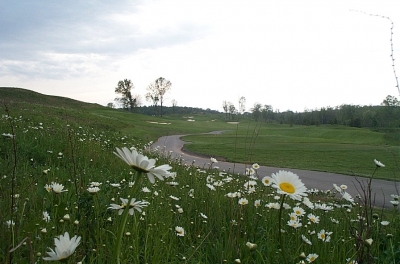 |
| Wildflowers are a small part of the beauty at Whiskey Creek. |
The song's lyrics paint a patriotic tribute to Maryland, and it's easy to see why the state's native sons (on both sides) used it as an anthem when fighting the War Between the States. Just listening to the song gives you a feel for what Maryland is all about.
Similarly, if there's a golf course that consolidates all that is Maryland, it's Whiskey Creek--near the little town of Ijamsville, about 35 minutes north and west of Washington D.C. Whiskey Creek opened last June, and together with its close neighbor, PB Dye Golf Club, gives northwestern Washington two incredible new public tracks within five minutes of each other.
Tom Saathoff, Whiskey Creek's General Manager/Head Golf Professional, says the setting is vintage Maryland: "I think our topography is very typical of Maryland -- lots of rolling terrain, hardwoods, a few pine trees, some elevation changes. Just being here, you get a true sense of the flavor that Maryland golf presents."
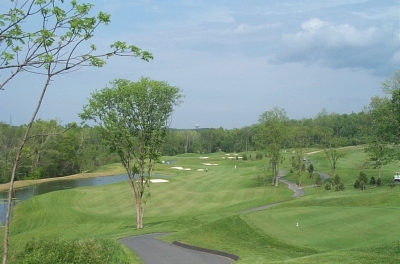 |
| Elevation changes are the norm at Whiskey Creek -- here, at least, it's downhill. |
Whiskey Creek is also two-time US Open Champion Ernie Els' first foray into the golf course design profession. I can't really say what the topography of South Africa looks like (Els' native country), but Ernie and co-designers JMP Golf Design sure did a tremendous job molding this piece of Maryland countryside into something special for recreational golfers. The scenery's so beautiful, it's almost 'intoxicating.'
The name Whiskey Creek stems from the club's proximity to Bush Creek, which legend has it was used to float barrels of whiskey down to the Monocacy River. The region's agricultural history is also represented in structural form on the property -- the stone ruins of an 1830's farmhouse occupies the middle of the eighteenth fairway. Perhaps it's a parody of the modern 'house golf' theme, but the ruins seem to fit the landscape very well. The theme works.
The one mile drive from the highway to the clubhouse sets the tone for the day -- a windy, narrow road that rolls over hills, through stands of trees and past rock formations -- and finally, a few of the golf holes. You'll scarcely believe your eyes when you see how the course is laid out. With all this surface variation on the drive in, you're sure you'll be hitting numerous blind drives and find greens perched on jagged cliffs.
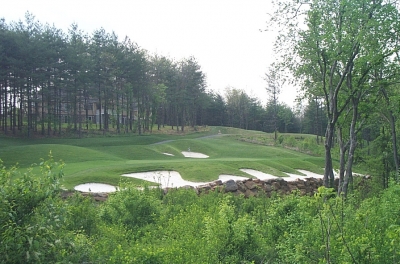 |
| You'll see the par three 11th hole on the drive into the course -- it'll get the juices flowing before you even reach the parking lot. |
Nothing's farther from the truth. Els and JMP did an outstanding job setting up each shot on the course, and there's really only one blind drive -- and even the setting of that hole (the twelfth) strongly suggests ball flight and distance required. To use an overused word -- the course is extremely 'playable.' If it's traditional to see every shot and present multiple playing options, this course is a classic already.
Photographer Jeff Janas summed it up when I met him at the course: "Look at this place -- it's incredible. It's my favorite golf course already, and I haven't even played it." I don't think Jeff's impressions changed once he got out on the course -- and while I'm not going to name a favorite course (in truth, I have about five), I'll certainly put this one high up amongst the best in the region.
The course's condition is also noteworthy. Seeing as Whiskey Creek's just reaching its first anniversary, you'd expect to see clumpy rough, bare spots in fairways and weak looking saplings bordering the holes. Not so. While not completely mature, it's amazing what conditions you'll find for a one-year old layout. It's obvious a great deal of thought went into creating the conditions for the opening, and how much work's been done in the time since. Excellent job.
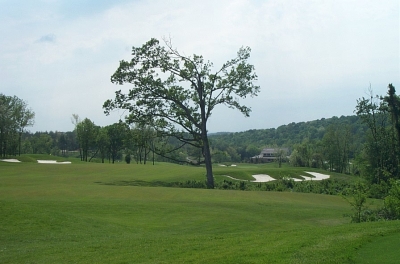 |
| You'll need to contend with this large oak tree on the par five 9th hole. |
The round begins with a mildly challenging, slightly uphill dogleg right par four, 406 yards from the back tees. There's generous room to hit a high fade if you've got it. Risk reward from the start of the round, hit too much slice and you're in one of two deep fairway bunkers that will certainly penalize you a stroke if you find them. In general, it's a good idea to steer clear of the bunkers -- more than usual on this course.
Saathoff says, "You need to keep it out of the bunkers. I think the bunkers are one of the tougher parts of the course." Based on my experience, I agree.
The third hole begins the best three-five-four par stretch on the course, and continues the journey up into the hills. The third measures 196 yards, and presents an uphill tee shot to a green guarded amply by bunkers on both sides. Nice hole to look at as well as play -- there are rock outcroppings at the back of the green (luckily don't really come into play unless you choose 2 clubs too much).
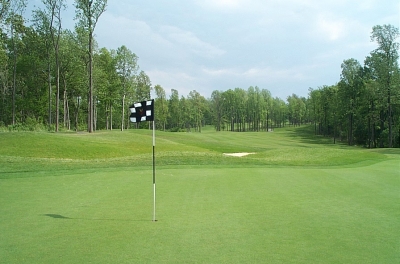 |
| Up on the ridge, the wind really 'freshens' a good part of the time. |
Four is a tremendous, wide, long--par five, 558 yards, mostly uphill, trees on both sides. Not really reachable for anyone below the architect's level, even the second shot presents a generous landing area. You'll get quite a feel of isolation up near the green, with rocks to the right and trees all around. Quite a spectacular hole -- one I'm sure Els would put on many a US Open course.
Five presents the most spectacular tee shot on the course, with views to match. There's a hundred foot drop between tee and green, with a slight dogleg left inviting more club off the tee -- but that brings the bunkers into play. The hole features one of the smallest greens on the course, so you'll want to leave as short an approach shot as possible.
Six is a nice short par four, not really drivable at 344 yards and uphill. The fairway's still fairly generous, which invites you to grip it n' rip it if you choose, and play a half sand wedge into the sloping green.
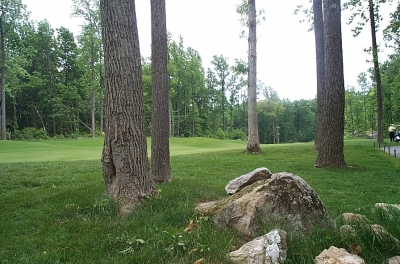 |
| Rock outcropping demonstrate that building this course was no easy task. |
The outward nine concludes with a dogleg right par five, 545 yards from the back. The day we played it was into the wind, so going for it in two wasn't an option. The tee shot's shaped by a large oak tree that invites you to go left or right of it -- or from the forward sets of tees -- over. Depending on the success of your drive, reaching the green in two is a possibility (on a day when the wind's friendlier, too).
Number eleven's an aesthetically pleasing par three, 198 yards, downhill and trouble all around. There's a bunker running the length of the green, a rock wall short of it, and a steep hillside and bunker long. The green is long and medium width. Mostly a visual test, but still a great hole.
Twelve presents the lone blind tee shot of the day, but presents the option of teeing with less club and landing it on top of the plateau (which you can see just fine), or trying to take it down over the horizon. If you choose the short and safe route, you'll be hitting a long iron over a large ravine for your approach -- a hole with a double forced carry.
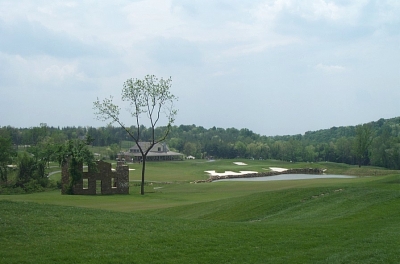 |
| In arguably the Mid-Atlantic's most memorable finishing hole, you've got ruins right in the middle of the 18th fairway. |
Fourteen will also test your driving savvy -- with an elevated tee shot to what looks like a very narrow fairway with water down the entire left side. There's a lot of room to the right, including the sixteenth fairway -- and making par after a sliced drive is still possible, as I found out.
Seventeen's a 425 yard, steeply uphill par four. You won't be able to see the green on your second (you can see the flag though), and you'll find a two-tiered putting surface when you get there. Pay close attention to your cart's GPS for the yardage to the flag, and take an extra club to reach the upper tier.
The final hole is more than a signature, it's a grand send off. How many holes can you think of with stone ruins in the middle of the fairway? Another risk-reward -- go to the narrower left side of the ruins and possibly flirt with rough and wetlands, but have a chance to go at the green in two. Anything to the right will require a lay-up. Third shot's over water to a large and relatively flat green. A tremendous finishing hole, one you won't forget.
All in all, it'll be hard not to remember a round at Whiskey Creek, only for the fact it's a very memorable place. It's got real Maryland flavor, historical significance and a great golf course. Almost like it's set it to music.
Details:
Whiskey Creek Golf Club
4804 Whiskey Court
Ijamsville, MD 21754
Phone: (888) 883-1174; (301) 694-2900
Website: www.whiskeycreekgolf.com
Course Designers: Ernie Els and JMP Golf Design
General Manager/Head Golf Professional: Tom Saathoff
| Tees | Yardage/Slope |
| Black | 7001/137 |
| Blue | 6525/136 |
| White | 5979/128 |
| Red | 5296/121 |
Rates:
Mon-Thurs $75; Fri-Sun $90.
Twilight: Mon-Thurs $52; Fri-Sun $56.
Includes the greens fees, cart fees, range balls and the GPS system.
| Related Links | Comments on this article? | |
|
Maryland National Golf Club Hollow Creek Golf Club Rocky Gap Resort PB Dye Golf Club in Ijamsville Whiskey Creek Golf Club |
E-mail Jeff Rendall, Editor: jrendall@golftheunitedstates.com |












